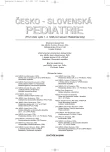-
Medical journals
- Career
Therapeutical Approaches in Anemia of Prematurity
Authors: S. Šebková 1; J. Zach 1; J. Janota 1,2
Authors‘ workplace: Novorozenecké oddělení s JIPN, Fakultní Thomayerova nemocnice s poliklinikou, Praha-Krč primář MUDr. J. Janota, PhD. 1; Ústav patologické fyziologie UK 1. LF, Praha přednosta prof. MUDr. E. Nečas, DrSc. 2
Published in: Čes-slov Pediat 2009; 64 (7-8): 352-358.
Category: Review
Overview
Anemia is the most common hematological disorder in the neonate. During the first weeks of life, all infants experience a decline in blood hematocrit values. The main cause of anemia is a rapid fall in erythropoietin production after birth due to increased oxygen saturation. This process is called physiologic anemia of the newborn. Anemia of prematurity is related to a combination of factors including increased iatrogenic losses from blood sampling, shorter red blood cells life span due to fetal hemoglobin, and rapid growth.
Blood transfusion remains still the gold standard in the treatment of anemia of prematurity. Between 60 to 100% of preterm infants (80% of VLBW and 95% of ELBW infants) are transfused before three weeks of age. The need of late transfusions decreases with the use of recombinant human erythropoietin. Despite an extensive number of studies, there is currently no clear consensus regarding erythropoietin benefit in the treatment of anemia of prematurity.Key words:
anemia of prematurity, blood transfusion, recombinant human erythropoietin, retinopathy of prematurity
Sources
1. Gomella TL, Cunningham MD, et al. Neonatology. 5th ed. The McGraw-Hill Companies, Inc, 2004 : 334–340.
2. Miyashiro A, et al. Strict red blood cell transfusion guideline reduces the need for transfusions in very-low-birthweight infants in the first 4 weeks of life: a multicentre trial. Vox Sang 2005;88 : 107–113.
3. Rennie JM. Roberton’s Textbook of Neonatology. 4th ed. Elsevier, 2005 : 741–751.
4. Fetus and Newborn Committee. Red blood cell transfusions in newborn infants: Revised guidelines. Paediatrics and Child Health 2002;7(8): 553–558.
5. Paul DA, Leef KH, et al. Transfusion volume in infants with very low birth weight: A randomized trial of 10 versus 20 ml/kg. J. Pediatr. Hematol. Oncol. 2002; 24 : 43–46.
6. Mainie P. Is there a role for erythropoetin in neonatal medicine? Early Human Development 2008;84 : 525–532.
7. Widness JA, Sawyer ST, et al. Lack of maternal to fetal transfer of 125l-erythropoietin in sheep. J. Dev. Physiol. 1991;15 : 139–143.
8. Zanjani ED, Pixley JS, et al. Erythropoietin does not cross the placenta into the fetus. Pathobiology 1993;61(3–4): 211–215.
9. Widness JA, Phillips AF, et al. Erythropoietin levels and erythropoiesis at birth in infants with Potter’s syndrome. J. Pediatr. 1990;117 : 155–158.
10. Maier RF, Obladen M, et al. High-versus low-dose erythropoietin in extremely low birth weight infants. J. Pediatr. 1998;132 : 866–870.
11. Juul SE. Enterally dosed rekombinant human erythropoietin does not stimulate erythropoiesis in neonates. J. Pediatr. 2003;143 : 321–326.
12. Pasha YZ, Ahmadpour-Kacho M, et al. Enteral erythropoietin increases plasma erythropoietin level in preterm infants: a randomized controlled trial. Indian. Pediatr. 2008;45 : 25–28.
13. Ohlsson A, Aher SM. Early erythropoetin for preventing red blood cell transfusion in preterm and/or low birth weight infants. Cochrane Database Syst. Rev. 2006;3.
14. Suk KK, Dunbar JA, et al. Human recombinant erythropoietin and the incidence of retinopathy of prematurity: a multiple regression model. J AAPOS 2008;12 : 221–222.
15. Wei L, Han BH, et al. Cell death mechanism and protective effect of erythropoietin after focal ischaemia in whisker-barrel cortex of neonatal rats. J. Pharmacol. Exp. Ther. 2006;317 : 109–116.
16. Demers EJ, McPherson RJ, et al. Erythropoetin protects dopaminergic neurons and improves neurobehavioural outcomes in juvenile rats after hypoxia-ischaemia. Pediatr. Res. 2005;58 : 297–301.
17. Siddappa AM, Rao R, et al. The assesment of newborn Iron Stores at birth: A review of the literature and standards for ferritin concentrations. Neonatology 2007;92 : 73–82.
18. Rao R, Georgieff MK. Iron in fetal and neonatal nutrition. Seminars in Fetal and Neonatal Medicine 2007;12 : 54–63.
19. Agget PJ. Trace elements of the micropremie. Clin. Perinatol. 2000;27 : 119–121.
20. Aggett PJ, Agostoni C, et al. Iron metabolism and requirements in early childhood: Do we know enough? A commentary by the ESPGHAN committee on nutrition. J. Pediatr. Gastroenterol. Nutr. 2002;34 : 337–345.
21. Aher SM, Ohlsson A. Early versus late erythropoietin for preventing blood cell transfusion in preterm and/or low birth weight infants. Cochrane Database Syst. Rev. 2007;4.
22. Vento M, Vina J, et al. Erythropoietin and iron therapy for preterm infants. J. Pediatr. 1999;134 : 520.
23. The Canadian Pediatric Society. Red blood cell transfusions in newborn infants: Revised guidelines. Pediatr. Child Health 2002;7(8): 553–558.
Labels
Neonatology Paediatrics General practitioner for children and adolescents
Article was published inCzech-Slovak Pediatrics

2009 Issue 7-8-
All articles in this issue
- Complications of Varicella in Children
- The Role of ABCB4 Gene Variation in Etiology of Idiopathic Cholelithiasis at the Child Age
- Vitamin D – an Old Vitamin from a New Perspective
- Therapeutical Approaches in Anemia of Prematurity
- Intrauterine Growth Retardation and Its Influence on Further Development of Extremely Immature Newborns
- Prenatal Life from the Ethical Standpoint
- Ethical Context of sc. „Baby-boxes“
- Spa for Children – Therapy or Recreation?
- Czech-Slovak Pediatrics
- Journal archive
- Current issue
- Online only
- About the journal
Most read in this issue- Therapeutical Approaches in Anemia of Prematurity
- Intrauterine Growth Retardation and Its Influence on Further Development of Extremely Immature Newborns
- Vitamin D – an Old Vitamin from a New Perspective
- Complications of Varicella in Children
Login#ADS_BOTTOM_SCRIPTS#Forgotten passwordEnter the email address that you registered with. We will send you instructions on how to set a new password.
- Career

